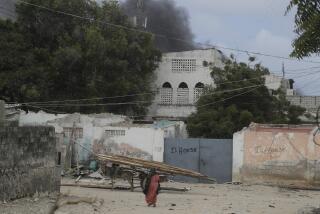Conditions may be ripe for Al Qaeda to gain in Somalia
NAIROBI, KENYA — Conventional wisdom long held that Somalia was so inhospitable that even Al Qaeda gave up trying to gain a foothold amid feuding clans, erratic warlords and a wily population hardened by years of anarchy.
Now, in the wake of an aggressive U.S. counter-terrorism program that has alienated many Somalis, there are signs that Al Qaeda may have its best chance in years to win over Islamic hard-liners in the Horn of Africa nation.
After once denying or downplaying links to the terrorist network, a senior leader of Somalia’s most notorious Islamic militia now acknowledges that his group has long-standing ties to Al Qaeda and says he is seeking to forge a closer relationship.
“We are negotiating how we can unite into one,” said Muktar Robow, a top military commander of Shabab, which the U.S. State Department designated a terrorist organization this year. “We will take our orders from Sheik Osama bin Laden because we are his students.”
Merging with Al Qaeda operatives in the region makes sense, he said, given the recent U.S. crackdown, including a May 1 airstrike that killed Shabab’s previous commander.
“Al Qaeda is the mother of the holy war in Somalia,” he said. “Most of our leaders were trained in Al Qaeda camps. We get our tactics and guidelines from them. Many have spent time with Osama bin Laden.”
U.S. officials said it’s unclear whether Shabab’s threat is real or just anti-Western rhetoric intended to rattle U.S. intelligence officials. Analysts note that Al Qaeda faces the same challenges that prevented it from establishing a Somalia base before, including power struggles among the country’s Islamists, competition from local clan networks and differences between those seeking to focus attacks in Somalia and those favoring Al Qaeda’s global agenda.
U.S. Ambassador Michael E. Ranneberger acknowledged growing links between Shabab and Al Qaeda, but said ties remained in the early stages.
“There are indications of a fairly close Shabab-Al Qaeda connection, though it’s not clear to what extent they’ve been operationalized,” he said. “Is Shabab taking orders from Al Qaeda? I would say no. They are still running their own show.”
Robow said Shabab has been boosting its forces in recent months with an influx of fighters from around the world, including Kenya, Sudan, Iraq, Afghanistan, Algeria, Indonesia, Chechnya and even the United States. Al Jazeera recently aired footage of a masked Shabab commander who called himself Abu Mansur al-Amriki and spoke with an American accent. His identity could not be confirmed.
Robow declined to comment on the number of foreigners or the size of Shabab’s militia. One analyst recently estimated its forces at 1,000 to 3,000 fighters.
Robow also spoke for the first time about eventually expanding Shabab’s activities outside Somalia’s borders, saying Americans, even journalists and aid workers, were not immune from attack because of what he called “the aggression of the American government.”
“Once we end the holy war in Somalia, we will take it to any government that participated in the fighting against Somalia or gave assistance to those attacking us,” he said.
Analysts say such talk highlights a growing radicalization of Somalia’s Islamists. Although Somalia has long had hard-liners, most of the population practiced a moderate form of Islam, and even extremists limited attacks to inside the country or against Ethiopia, a longtime rival.
But some worry a more radical agenda in Somalia has been aided by U.S. counter-terrorism efforts during the last two years, including half a dozen airstrikes against suspected terrorist targets that often killed civilians.
Somalia’s citizens are also outraged by the ongoing occupation of Mogadishu by Ethiopian troops, who came in 2006 to defeat a short-lived Islamic government that had taken power largely with help from Shabab fighters.
“For Al Qaeda, the projection seems good now,” said Richard Barno, counter-terrorism analyst at the Institute for Security Studies in Addis Ababa, Ethiopia’s capital, noting that Somalia’s U.N.-backed transitional government has been weakened by infighting.
But Barno cautioned that Al Qaeda still faced resistance from Somalia’s major clans, which so far have been less interested in radical anti-Western attacks and frown upon Al Qaeda’s signature large-scale attacks, particularly when they result in civilian casualties. Clan leaders also have been reluctant to send their men to fight with Al Qaeda outside Somalia, he said.
“Any moving to Al Qaeda might alienate the clans,” Barno said. “And they can’t afford to do that because the clans provide their foot soldiers.”
Robow said Shabab’s roots lay with the collapse of Mohamed Siad Barre’s military regime in 1991, the last time Somalia had a functioning government. With help from a team of fighters sent by Bin Laden, he said, future Shabab leaders cut their teeth killing U.S. forces in 1993, including the downing of a U.S. Black Hawk helicopter, which led to the deaths of 18 U.S. soldiers.
U.S. intelligence agencies took note after the 1998 U.S. Embassy bombings in Kenya and Tanzania. Somalia’s Islamic hard-liners were accused of harboring the Al Qaeda operatives who executed the attacks.
Ambassador Ranneberger asserted that U.S. counter-terrorism efforts, combined with efforts by Ethiopia and Kenya, have diminished the Al Qaeda threat and thwarted several plots. “They are still a threat, but clearly their network and operations have been degraded,” the ambassador said.
But Robow said U.S. counter-terrorism efforts over the last two years have only strengthened his group. “I’m telling you,” he said, “the more Americans move against us, the more popular we become.”
--
More to Read
Sign up for Essential California
The most important California stories and recommendations in your inbox every morning.
You may occasionally receive promotional content from the Los Angeles Times.









